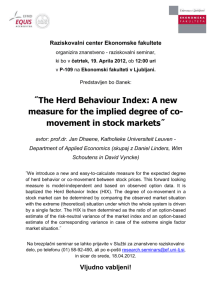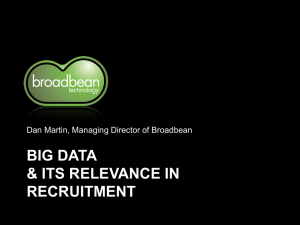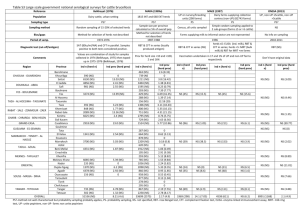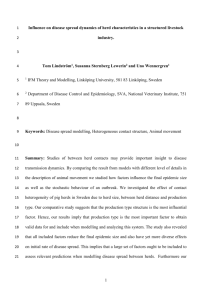CEPLSEHerdBehaviourTalkNovember2011
advertisement
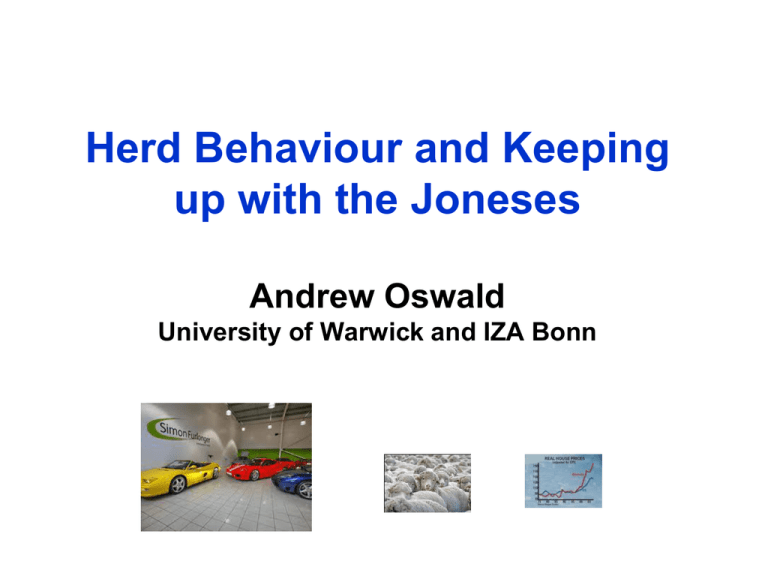
Herd Behaviour and Keeping up with the Joneses Andrew Oswald University of Warwick and IZA Bonn I would like to understand human imitation and herd behaviour. Today we’ll look at: Today we’ll look at: Brain scan evidence Today we’ll look at: Brain scan evidence Statistical evidence Today we’ll look at: Brain scan evidence Statistical evidence The mathematics of herd behaviour The distribution of life-satisfaction levels among British people 35 Percentage of Population 30 25 20 15 10 5 0 1 2 3 4 5 6 Self-rated Life Satisfaction N = 74,481 7 The classic herding article: • Hamilton, W. D. (1971). "Geometry for the Selfish Herd". Journal of Theoretical Biology 31 (2): 295–311. • Hamilton, W. D. (1971). "Geometry for the Selfish Herd". Journal of Theoretical Biology 31 (2): 295–311. MSc L.S.E. Why does herding happen? Why does herding happen? When a T Rex dinosaur comes in the room, it is your relative position that matters. So suggested: • Hamilton, W. D. (1971). "Geometry for the Selfish Herd". Journal of Theoretical Biology 31 (2): 295–311. Before that article, the standard theory in biology was that herds had some inexplicable communitarian instinct. Instead, Hamilton argued: Instead, Hamilton argued: A rational animal clusters with the others – Instead, Hamilton argued: A rational animal clusters with the others – because its relative position is what matters. The herd instinct even seems to exist in baby animals who have never seen a predator. • Title: Predatory threat induces huddling in adolescent rats and residual changes in early adulthood suggestive of increased resilience Author(s): Kendig Michael D.; Bowen Michael T.; Kemp Andrew H.; et al. Source: BEHAVIOURAL BRAIN RESEARCH Volume: 225 405-41 DEC 1 2011 Kendig et al 2011 Young male rats were exposed to 30 min of cat fur exposure in a large arena. Cat fur exposure was found to elicit a distinct defensive response in which groups of adolescent rats huddled together in the corner of the arena....relative to control rats. “Interestingly, huddling was most pronounced in rats receiving intermittent alcohol.” For biologists and zoologists, this is now the dominant theoretical explanation for herd behaviour. By contrast By contrast Most economists who study herd behaviour prefer to view it as ‘informational learning’. By contrast Most economists who study herd behaviour prefer to view it as ‘informational learning’. Banerjee in the QJE, etc. Yet fashion is ‘pure’ imitation Yet fashion is ‘pure’ imitation So I reckon we need to think about human imitation caused by sheer keeping-up desires*. *even if heavily subconscious Before getting to equations, let’s start with everyday empirical evidence. Consider your wrist. 5 euros 500000 euros “A watch defines a man's look and tone.” Rolex advert. “A watch defines a man's look and tone.” Rolex advert. Subconsciously, humans seem frightened of falling behind. • So let us hypothesise that human beings care about their relative position. • So let us hypothesise that human beings care about their relative position. Duesenbery, Easterlin, Frank, Hirsch, Layard, Runciman, Veblen, ... There are now results • From fMRI scans • From statistical work on well-being This includes new empirical work: Armin Falk and colleagues on relative-income images in the brain (Science, Journal of Public Economics) Peter Kuhn and colleagues on car purchasing by neighbours of lottery winners (AER forthcoming) Ori Heffetz on visible goods (REStats forthcoming). David Card, Alexandre Mas, Enrico Moretti, Emmanuel Saez on peers and satisfaction. Two papers I would greatly recommend. • Title: Social comparison affects rewardrelated brain activity in the human ventral striatum Author(s): Fliessbach K, Weber B, Trautner P, et al. Source: SCIENCE Volume: 318 Issue: 5854 Pages: 1305-1308 Published: NOV 23 2007 • Title: Relative versus absolute income, joy of winning, and gender: Brain imaging evidence Author(s): Dohmen T, Falk A, Fliessbach K, et al. Source: JOURNAL OF PUBLIC ECONOMICS Volume: 95 Issue: 3-4 Special Issue: Sp. Iss. SI Pages: 279-285 Published: APR 2011 We are now able to look inside the brain. Armin Falk et al Armin Falk et al While being scanned in adjacent MRI scanners, pairs of subjects had to perform a task with monetary rewards for correct answers. Variation in the comparison subject's payment affected blood oxygenation level-dependent (BOLD) responses in the ventral striatum. Variation in the comparison subject's payment affected blood oxygenation level-dependent (BOLD) responses in the ventral striatum. This brain region is engaged in the registration of primary rewards. Falk et al in Science and JPubEcon Parameter estimates 1.2 0/0 30/0 60/0 0/60 0/30 30/60 30/30 60/30 60/120 60/60 120/60 0.8 0.4 0.0 -0.4 -0.8 -1.2 C1 C2 C3 C4 C5 C6 C7 C8 C9 C10 C11 0.2 0.2 A correct, B not A not correct Conditions of interest (both correct) A’s income : B’s income 1:2 % Signal change ROI-defining conditions 0.1 0.1 0 0.0 -0.1 -0.1 -0.2 -0.2 1:1 2:1 0 4 8 12 Time (sec) Time (sec) 16 16 20 Falk et al in Science and JPubEcon • “The mere fact of outperforming the other subject positively affected reward-related brain areas.” Parameter estimates 1.2 0/0 30/0 60/0 0/60 0/30 30/60 30/30 60/30 60/120 60/60 120/60 0.8 0.4 0.0 -0.4 -0.8 -1.2 C1 C2 C3 C4 C5 C6 C7 C8 C9 C10 C11 0.2 0.2 A correct, B not A not correct Conditions of interest (both correct) A’s income : B’s income 1:2 % Signal change ROI-defining conditions 0.1 0.1 0 0.0 -0.1 -0.1 -0.2 -0.2 1:1 2:1 0 4 8 12 Time (sec) Time (sec) 16 16 20 The next slide -- very briefly -is for specialists. Blood-oxygenation equations Table: Activation and Income Dependent v ariable: v entral striatum activ ation (1) (2) (3) all conditions conditions 2-11 conditions 6-11 Own Income (in 100 Euro) Other's income (in 100 Euro) Constant Observ ations R-squared 0.916*** [0.109] -0.666*** [0.087] -0.119 [0.144] 704 0.059 0.868*** [0.102] -0.714*** [0.086] -0.061 [0.145] 640 0.063 0.327*** [0.091] -0.353*** [0.090] 0.068 [0.167] 384 0.011 OLS estimates; clustering on indiv iduals, robust standard errors in brackets; *** p<0.01, ** p<0.05, * p<0.1 • (similar with fixed effects, main variation across Ss) So, inside your brain So, inside your brain You simply want to be high up the monkey pack Here is a different kind of data and evidence. It has been found that It has been found that Relative-income variables show up consistently in well-being equations. It has been found that Relative-income variables show up consistently in well-being equations. E. Luttmer, Quarterly Journal of Economics 2005 A. E.Clark et al, JPubEcon 1996, JELit 2008 GDA Brown et al, Industrial Relations 2008 and Psychological Science 2010 D. Card et al, NBER paper, 2011. A person’s happiness and mental health = f(their relative income). Andrew E Clark Why would we care about these things? Real house prices in the United States over the century The dotcom bubble: 2000-1 But potentially this issue goes far beyond economics. The hair ‘bubble’ Hat mania Peers and health choices Social norms in other ways Perhaps even 2011 in the UK Now let’s think of the likely mathematics. Consider the analytical foundations of imitation and herd behaviour. Much in the next few slides will rest on whether the happiness from status is accelerating or decelerating. Which of them is true of you, do you think? Does your happiness from status accelerate as you go up in status? Does your happiness from status accelerate as you go up in status? [convex] Does your happiness from status accelerate as you go up in status? [convex] Or do you get diminishing marginal returns? Does your happiness from status accelerate as you go up in status? [convex] Or do you get diminishing marginal returns? [concave] Accelerating happiness from status is f(.) convex Decelerating happiness from status is g(.) concave Imagine a person is choosing an action a to get the greatest utility: where a* is what everyone else is doing. Imagine a person is choosing an action a to get the greatest utility: Maximize u(a) + v(a – a*) – c(a) where a* is what everyone else is doing. • u(a) is the direct bit of utility • u(a) is the direct bit of utility (if my car can go fast I really can get to Oxford more quickly) • u(a) is the direct bit of utility (if my car can go fast I really can get to Oxford more quickly) • u(a) is the direct bit of utility (if my car can go fast I really can get to Oxford more quickly) • u(a) is the direct bit of utility (if my car can go fast I really can get to Oxford more quickly) • u(a) is the direct bit of utility (if my car can go fast I really can get to Oxford more quickly) • v(a – a*) is the indirect bit of utility • v(a – a*) is the indirect bit of utility (if my car can go fast then subconsciously I feel superior to others as I drive to Oxford) Putting these together Putting these together Maximize u(a) + v(a – a*) – c(a) a* is what other people are doing a is my action • Let’s think back to watches. What is your rational choice of action, a? Do I buy a better watch when you do? Do I buy a better watch when you do? Well the sign of da/da* is given by the sign of the second derivative of v(a-a*). I choose my optimal action a Differentiating, we have: uʹ(a) + vʹ(a – a*) – cʹ(a) = 0 where a* is what everyone else is doing. Around the optimum We have: da[u″(a)+ v″(a – a*) – c″(a)] – da*v″(a – a*) = 0 where a* is what everyone else is doing. Then if v is concave (convex) in status, it is rational to act similarly to (deviantly from) the herd. v″(a - a*) ≤ 0 I do the same as you Then if v is concave (convex) in status, it is rational to act similarly to (deviantly from) the herd. v″(a - a*) ≥ 0 I do the opposite of you • Concavity of v(.) leads to emulation • Convexity of v(.) leads to the opposite. Joint work with Andrew Clark This matters because, for example, we need to have an explanation for the simultaneous occurrence of obesity and anorexia. When might v(.) be convex? When might v(.) be convex? The utility increment going from 3rd in the world to 2nd in the world is going to be much bigger than going from 8th to 7th. • So maybe v(a –a*) goes convex at the extreme end of a status distribution. • So maybe v(a –a*) goes convex at the extreme end of a status distribution. “You can never be too rich or too thin” — Wallis Warfield Simpson Overall, in my judgment: Overall, in my judgment: • This parameter v″(a - a*) is one of the most fundamental in all of social science. Overall, in my judgment: • This parameter v″(a - a*) is one of the most fundamental in all of social science. • Yet we have little idea of its size or even often what sign it takes. So what? Why might it matter to social scientists if utility depends on relative things? The first reason It has a disturbing possibility. Maybe • Modern society is stuck. • Individually, we chase higher income and ‘rank’, but for society as a whole this cannot be achieved. Here’s an evocative quote. • “In a poor country, a man proves to his wife that he loves her by giving her a rose, but in a rich country, he must give a dozen roses.” • “In a poor country, a man proves to his wife that he loves her by giving her a rose, but in a rich country, he must give a dozen roses.” - Economist Richard Layard www.teleflorist.co.uk www.teleflorist.co.uk 50 roses for £159 Nash equilibrium A second possibility: excessive herding. The importance of relative things to well-being may provide an important clue about what has driven the Credit Crunch. • "Men … think in herds; they go mad in herds, … they only recover their senses slowly, and one by one." C. Mackay Extraordinary Popular Delusions and the Madness of Crowds, by Charles MacKay, published in 1841. Extraordinary Popular Delusions and the Madness of Crowds, by Charles MacKay, published in 1841. Far from the Madding Crowd, by Thomas Hardy, published in 1874. Herd behaviour is very often natural and individually rational. But it has the potential to be disastrous for the group. Herd behaviour is very often natural and individually rational. But it has the potential to be disastrous for the group. When rewards depend on your relative position it will routinely be When rewards depend on your relative position it will routinely be (i) dangerous to question whether the whole group’s activity is flawed (ii) rational simply to compete hard within the rules that govern success. When rewards depend on your relative position it will routinely be (i) dangerous to question whether the whole group’s activity is flawed (ii) rational simply to compete hard within the rules that govern success. Correct dotcom analysts were fired. In financial markets, people are now routinely rewarded in a way that depends on their relative performance. Top quartile, second quartile, etc. That’s dangerous: Summing up The main ideas The main ideas 1. Imitation is intrinsic to human life. 2. It is often driven by relative feelings; this links it to biology and real herds. 3. The crucial parameter is v″(a – a*) . 4. We need to understand herd behaviour better in social science. 5. The madness of crowds will be back. The main ideas 1. Imitation is intrinsic to human life. 2. It is often driven by relative feelings; this links it to biology and real herds. 3. The crucial parameter is v″(a – a*) . 4. We need to understand herd behaviour better in economics. 5. The madness of crowds will be back. Herd Behaviour and Keeping Up with the Joneses Andrew Oswald University of Warwick and IZA Bonn
